The Mainsail
Revised 1/31/01
|
The Mainsail Revised 1/31/01 |
|
|
|
|
|
|
The Overview page includes the parts of the sail, and that information won't be repeated in detail here. But I did want to show some additional detail of the typical gaff main sail. To recap that information, the luff is that vertical portion of the sail that is nearest the mast, and the leech is the vertical portion farthest away from the mast. The head and foot of the mainsail are located in their logical places at the top and bottom of the sail.
The sail itself is best proportioned with the following ratios: luff 1.0, head 0.833, leech 1.73 and foot 1.02, according to John Leather's The Gaff Rig Handbook. This "best proportion" is not always followed, of course, but in Leather's ideal gaff main sail, the angle of the gaff to the mast should be at 30 degrees, and the boom should rake upwards about 6 degrees (allowances must be made here for the height of the gooseneck, deckhouses, etc.) It seems to me that the luff is a good starting point, as you know how high your throat halyard will raise the sail. Multiplying the factors he gives by the luff length to find the dimensions of the head and the foot seem reasonable, and the length of the leech then sets the angle of the top of the sail.
The Weekender I'm building specifies a main sail with a luff of 118". The corresponding head of the sail should be 98" according to Leather, but it is 68" on my plans. The foot on my sail plan is 127", while Leather's formula would put it smaller at 120" (the luff of 118" x the factor of 1.02 equals 120".) Fair enough, so far: the designers of the Weekender have a slightly longer foot, and a head that is just 2/3 of the size Leather recommends. I would expect that the dimension of the leech in my plan would then be longer ... it starts 7" farther out on the boom, and angles in at the head another 30". But the leech length on my plan is 170", while Leather's formula would put it at 204". That tells me the planned angle of the top of the sail, with the peak halyard made fast, is at an angle less than Leather suggests. And the sail on my boat is smaller than the "ideal proportions" would suggest. I will build the sail to the designer's proportions first, but experiment with the "ideal" sail later on. That will require another gaff, as the gaff specified is a mere 74" long on my plans.
Leather uses these proportions for those gaffers that will not be flying a topsail. With a topsail, he recommends easing the gaff to an angle of 42 degrees to the mast, and I would think allowances would have to be made to the leech to accommodate this.
Designer Michael Kasten, of Kasten Marine Designs uses a unique sail plan that eliminates one halyard, so the sailor has but one halyard to raise and position the gaff. Michael was generous enough to provide me with some of his drawings. These are wonderful designs, with tall gaff mainsails that are much different from Leather's "ideal" sail. Redpath, a wonderful gaff schooner reproduced below, has a luff of 29'. Using Leather's dimensions, we would expect a head just over 24' long, a leech angling down for a length of just over 50', and a foot 29' 6". But Kasten's successful design, which allows a single sailor to raise the sail, has a narrower head of just 8' 2". The gaff in the illustration below is set much less than the 30 degrees Leather provides, and the leech is just slightly longer than the luff at 30' 9". Appropriate for his schooners, the foot is a mere 13' 6" instead of the 29' 6" the traditional dimensions would predict.
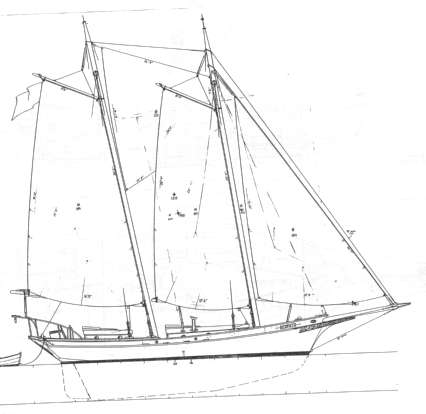
 Here's
a higher resolution scan of the halyard rigging. The exact placement
of the ends of the bridle along the short gaff is determined during the
sea trials, but the method seems to work well. Michael offered an
explanation of his inspiration for this unusual design:
Here's
a higher resolution scan of the halyard rigging. The exact placement
of the ends of the bridle along the short gaff is determined during the
sea trials, but the method seems to work well. Michael offered an
explanation of his inspiration for this unusual design:
"One detail which may be of interest to you and your readers is that many of the gaff rigs that I've specified make use of a single halyard for the gaff. It is made possible by the relatively short gaffs that I prefer, arranged much like the gaff rigs on the Baltimore Pilot Vessels of the last century."
"As I have discovered on my own 34 foot gaff schooner EMERALD, with short gaffs there is no need for a peak halyard. Luff tension is adjusted at the gooseneck. The benefit is to simplify the rig, to always keep the gaff in the same attitude while raising and lowering, to increase luff length for better windward sailing, to reduce weight aloft, and to eliminate those pesky tops'ls.""On a schooner I do like to use a fisherman tops'l, as it provides enough area to be of excellent use. The gaff tops'ls however are more trouble than they are worth (IMHO)."
Michael Kasten, November 20, 2000
The fisherman's topsail is rigged between the fore and aft mast
on a schooner, so those of us with a sloop, with its single mast, are out
of luck here.
The cut of the sail receives treatment from Tom Cunliffe in Hand Reef and Steer. He allows that gaff mainsails vary considerably in shape, but recognizes only two cuts (or, two methods of joining the strips of sailcloth together to form the sail.) A vertically cut sail would have the seams joining the sailcloth strips running from top to bottom, or vertically. A horizontal cut would have the seams running fore and aft, or horizontally. Cunliffe maintains that working craft used vertically cut sails while the pleasure yachts and racing vessels used horizontal cuts. Some said a tear in a vertical cut mainsail (which usually happens at the seams) could be compensated for by reefing, if the fates would have your sail tear conveniently below the reef points. A horizontal tear along a seam in a horizontally cut sail is a catastrophic failure. However, inducing a preferred "camber", the curvature of the sail when looking at a cross-section diagram when the sail is at right angles to the mast , is easier with a horizontal cut. A mumbled mention of extra windage for the vertical cut sail is offered, then withdrawn, as tests show that there is little difference between the two cuts in terms of windage. So the preference for horizontally cut sails, according to Cunliffe, seems to stem from the skill of sailmakers in inducing the correct amount of camber in them. Leather plainly prefers the horizontal cut sail (which he also calls cross-cut.) He holds to the less-windage theory, which Cunliffe dismisses, and dismisses the "catastrophic failure" of the horizontal cut sail as not likely in this day and age of advance synthetic sail materials.
Loose-footed or laced to the boom is given some attention by Leather. He declares a loose footed mainsail must be a vertically cut, or at least diagonally (introducing that cut for the first time in his book.) Attached at the luff side at the clew ( lowest corner of the luff) and at the leech side at the tack (the corresponding lowest corner of the leech.) Leather further explains that the tack is attached to the deck by a lanyard, although I am not at all clear here what he means, unless a block or fairlead on the end of the boom receives the lanyard attached to the tack, and then it is rove to the deck fitting. Michael Kasten, whose designs favor the loose-footed mainsail, includes this set up on his drawing for Lucille, a 50' schooner:
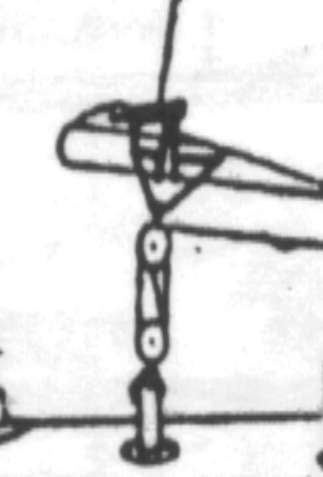
A more common sight on smaller craft, in my limited experience, is something
like a "horse" along the end of the boom, with an outhaul adjustment of
the tack possible by a lanyard running into the center of a modern hollow
boom (or through a traditional wooden one) towards the mast, to secure
there or nearby, so as to not have yet another line in the cockpit.
Adjustment is then made to this lanyard to control the depth of the "round"
in the foot of the sail. In Cunliffe's Hand Reef and Steer, this
design is presented:

The "horse" is the rod just below "E" that allows the clew to be pulled
towards the end of the boom by the line that is shown running from the
clew at "E", through the boom (you can see the faint "inside" block in
the boom in the illustration) and under the boom near "B" and finally to
"D", where the clew outhaul tackle is. We can see that it is made
fast to the boom itself, with the bitter end rove to a cleat near the boom
jaws.
Lacing the sail to the boom can be accomplished
on nearly any size craft by using a marlin-style lace:
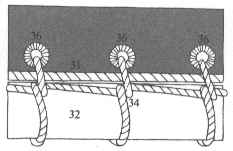
Although a number of other methods have their fans, including spiral
lacing and tieing each grommet to the boom with an individual loop.
Lacing to the boom is not unique to the gaff rig, and most books such as
Rigger's
Apprentice and Knowing
the Ropes have numerous examples. Leather includes some diagrams
of even more alternates, including attaching the foot to a batten affixed
on the boom.
Attaching the sail to the mast ...
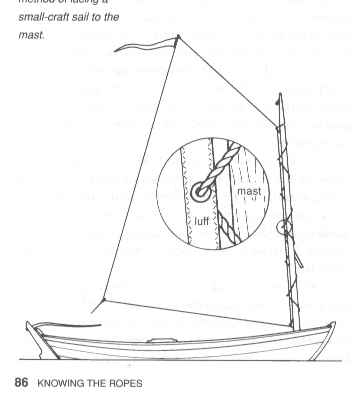 Here,
Roger
C. Taylor's excellent "Knowing
the Ropes" has an illustration I first identified as a "gaff rig drawing
without the gaff", but is probably a sprit rig, according to a very nice
email from Earl Woodworth. As Earl explained, "A sprit sail is similar
in shape to a gaff sail but is held aloft with a sprit which runs diagonally
from a point about midway up the mast to the tallest point of the sail.
In the drawing you can just see the end of the sprit projecting forward
of the mast. The sprit is controlled and the sail peaked with an arrangement
called a snotter. Basically a rope attatched to the sprit, lead over a
thumb cleat on the mast and back through the sprit or a loop in the snotter
and made fast. This rig is quite common on small traditional working craft
and also on some larger vessels such as the Thames barges." Thanks,
Earl, for the clarification!
Here,
Roger
C. Taylor's excellent "Knowing
the Ropes" has an illustration I first identified as a "gaff rig drawing
without the gaff", but is probably a sprit rig, according to a very nice
email from Earl Woodworth. As Earl explained, "A sprit sail is similar
in shape to a gaff sail but is held aloft with a sprit which runs diagonally
from a point about midway up the mast to the tallest point of the sail.
In the drawing you can just see the end of the sprit projecting forward
of the mast. The sprit is controlled and the sail peaked with an arrangement
called a snotter. Basically a rope attatched to the sprit, lead over a
thumb cleat on the mast and back through the sprit or a loop in the snotter
and made fast. This rig is quite common on small traditional working craft
and also on some larger vessels such as the Thames barges." Thanks,
Earl, for the clarification!
Even though I did err in identifying the rig at first, I've decided to leave it here to show an excellent method of spiral lacing of the sail to the mast. For small craft, lacing the sail as shown here works well, and avoids the cost of rigging mast hoops.
Roger identifies this as "forth and back" lacing, where on page 87 of his book he says "... go around the mast and through the lowest grommet in the luff of the sail, and then reverse direction and come back round the mast the opposite way" as shown above. By reversing direction each time you go through a grommet, you lace the sail to the mast with less friction, and it works much more smoothly. John Leather shows another method with reduced friction:
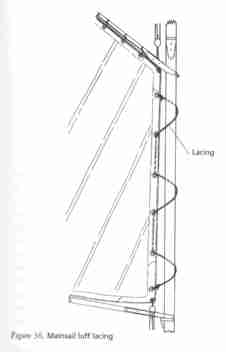
And there are other ways to lace a gaff sail to a mast:

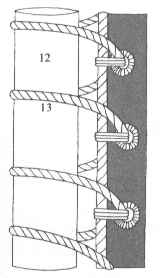
On the left is the standard spiral lacing, which is easy enough to see how to do. A more secure method is shown on the right, for larger sails where the sail needs to be secured at each grommet (from the out-of-print book "The Lore of Ships", 1975, by AB Nordbok, Gothenburg (no ISBN number, but the Library of Congress Card Number is 63-18428.)
Mast Hoops are often used to attach the
gaff sail to the mast, tied to the sail with small stuff, as shown here.
This is instead of lacing the sail to the mast. Here are two methods
to secure mast hoops to the main sail:

 Traditionally,
mast hoops are made of steamed, bent and riveted white oak, but common
on small craft and among the cheapies (like me), ABS couplers for DWV pipe,
sold by your local building supply store, are cut into 1/2 to 3/4" wide
hoops by sawing with a hacksaw (or better yet, a band saw.) You can
also buy plastic mast hoops already cut, although they are more expensive.
Another technique is to use a coupler as a form, and wrap edge banding,
a kind of veneer tape sold to cover the edges of plywood, around it 10
- 12 times, using contact cement to hold the layers to each other (or an
iron if you have the self-adhesive kind of edge banding.) Then the
finished mast hoop is stained, coated with 3 to 5 coats of varnish, or
a coat of epoxy and a few coats of varnish to protect the epoxy from UV
degradation (see my attempts at this at this
page, but use your browser's "back" button to return here.) The
formula for figuring how large to have the hoops is to size them about
25% larger than the largest diameter of the mast. For most small
craft, 3" or 4" diameters are usually fine, and provide a readily available
and inexpensive source for mast hoops. Sail
Rite sells 3 and 4" mast hoops out of steamed and bent white oak for
under $20 each.
Traditionally,
mast hoops are made of steamed, bent and riveted white oak, but common
on small craft and among the cheapies (like me), ABS couplers for DWV pipe,
sold by your local building supply store, are cut into 1/2 to 3/4" wide
hoops by sawing with a hacksaw (or better yet, a band saw.) You can
also buy plastic mast hoops already cut, although they are more expensive.
Another technique is to use a coupler as a form, and wrap edge banding,
a kind of veneer tape sold to cover the edges of plywood, around it 10
- 12 times, using contact cement to hold the layers to each other (or an
iron if you have the self-adhesive kind of edge banding.) Then the
finished mast hoop is stained, coated with 3 to 5 coats of varnish, or
a coat of epoxy and a few coats of varnish to protect the epoxy from UV
degradation (see my attempts at this at this
page, but use your browser's "back" button to return here.) The
formula for figuring how large to have the hoops is to size them about
25% larger than the largest diameter of the mast. For most small
craft, 3" or 4" diameters are usually fine, and provide a readily available
and inexpensive source for mast hoops. Sail
Rite sells 3 and 4" mast hoops out of steamed and bent white oak for
under $20 each.
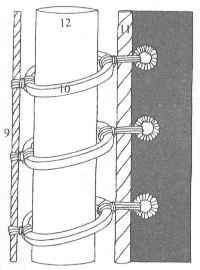 Note the
line along the left side of this illustration. This is
the "distance line," intended to keep the mast hoops an equal distance
from each other, and prevent them from hanging up as the sail is raised
and lowered. It is tied off to the top mast hoop and the bottom mast
hoop, and this is one line you don't have to do anything with while sailing.
While I've been told it is rarely neccessary on small craft, I did receive
an email from Daniel Boucher, a reader of these pages, stating that the
addition of the distance line helped on his small schooner, a 26 ft LOA
and 22.5 ft LOD boat you can see on his web page by clicking
here..
Note the
line along the left side of this illustration. This is
the "distance line," intended to keep the mast hoops an equal distance
from each other, and prevent them from hanging up as the sail is raised
and lowered. It is tied off to the top mast hoop and the bottom mast
hoop, and this is one line you don't have to do anything with while sailing.
While I've been told it is rarely neccessary on small craft, I did receive
an email from Daniel Boucher, a reader of these pages, stating that the
addition of the distance line helped on his small schooner, a 26 ft LOA
and 22.5 ft LOD boat you can see on his web page by clicking
here..

|
|
|
|
|
|